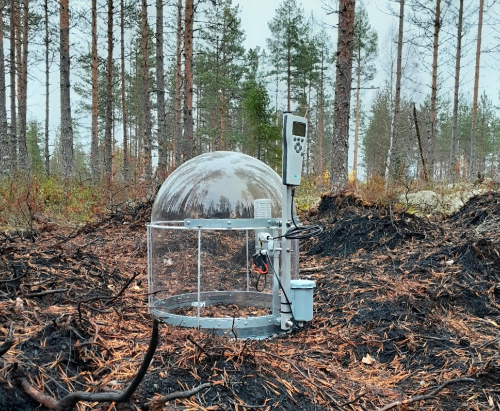Droid exploded Finnish woodlands
Aliens’ droid landed on Finnish woodlands and exploded the ground! Not exactly, but almost as exciting. Datasense and BioSorbio kicked off unique wildfire damaged forest recovery research. The project goal is to test BioRaiser treatment action on damaged soil and examine accelerated vegetation recovery influence on carbon emission. BioRaiser is a non toxic and completely biodegradable product, a hydrophilic seedbed and fertilizer with unrivaled performance. BioRaiser retains moisture up to 90% of its volume and releases it slowly to plant root systems.
The first stage was to assess soil and vegetation damages by measuring respiration and by inspecting area visually. We used Datasense Carbon Flux Analyzer to take carbon emission samples on wildfire area and surrounding forest for reference.
About 60% to 100% of the forest canopy and everything on the forest floor has burned. Overall damage is moderate. Some recovery has already happened since wildfire beginning of August 2021. The soil type is peat which is burned to 2-5 cm deep. However, gas analyzer indicated that soil bacteria is not completely destroyed.
Burned soil is recovering very slowly. The process depends highly on soil type, damage level and weather conditions. Our test area is wet peatland and did not burn very deep. The most serious damage seem to be happened to young pines.
In addition to respiration measurement, we installed Growth Watch soil sensors to monitor temperature, volumetric water content and conductivity from two reference points. One in BioRaiser treated and reference measurement in non-treated area.
At this time of the year soil temperature is relatively low 8 °C. During the wintertime, soil will be frozen and covered with snow. These are key reasons for moderate or almost non CO2 emission. During the spring and summer days, forest floor temperature may rise over 20°C. While humidity is very high on peatland, high soil temperature is generating optimal conditions for significant CO2 emissions. Wildfire burned forest becomes most likely major GHG source for long time after wildfire accident.
Research area is now treated with BioRaiser, and sensors are monitoring soil health continuously. Datasense sensors transmit data to cloud every two hours. In cloud services, data is processed and visualized automatically for further analysis.
Next steps. We monitor soil condition over the wintertime. Just before thermal growth season, we’ll make new respiration measurements with automated Carbon Flux Analyzers and BioSorbio will take laboratory soil samples. During the growth season 2022, carbon flux and soil condition monitoring will continue on the BioRaiser treated and reference points.


